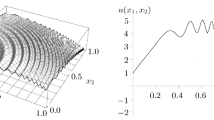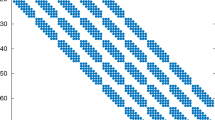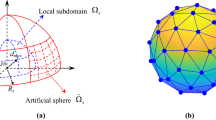Abstract
New h-, p-, and hp-versions of the least-squares collocation method are proposed and implemented. They yield approximate solutions of boundary value problems for an inhomogeneous biharmonic equation in irregular and multiply-connected domains. Formulas for the extension operation in the transition from coarse to finer grids on a multigrid complex are given in the case of applying various spaces of polynomials. It is experimentally shown that numerical solutions of boundary value problems produced by the developed versions of the method have a higher order of convergence to analytical solutions with no singularities. The results are compared with those of other authors produced by applying finite difference, finite element, and other methods based on Chebyshev polynomials. Examples of problems with singularities are considered. The developed versions of the method are used to simulate the bending of an elastic isotropic plate of irregular shape subjected to transverse loading.





Similar content being viewed by others
REFERENCES
A. Mayo, “The fast solution of Poisson’s and the biharmonic equations on irregular regions,” SIAM J. Numer. Anal. 21 (2), 265–299 (1984).
M. C. Lai and H. C. Liu, “Fast direct solver for the biharmonic equation on a disk and its application to incompressible flows,” Appl. Math. Comput. 164 (3), 679–695 (2005).
G. Chen, Z. Li, and P. Lin, “A Fast finite difference method for biharmonic equations on irregular domains and its application to an incompressible stokes flow,” Adv. Comput. Math. 29 (2), 113–133 (2007).
M. Ben-Artzi, I. Chorev, J. P. Croisille, and D. Fishelov, “A compact difference scheme for the biharmonic equation in planar irregular domains,” SIAM J. Numer. Anal. 47 (4), 3087–3108 (2009).
C. Davini and I. Pitacco, “An unconstrained mixed method for the biharmonic problem,” SIAM J. Numer. Anal. 38 (3), 820–836 (2000).
R. Eymard, T. Gallouët, R. Herbin, and A. Linke, “Finite volume schemes for the biharmonic problem on general meshes,” Math. Comput. 812 (280), 2019–2048 (2012).
H. Guo, Z. Zhang, and Q. Zou, “A C 0 linear finite element method for biharmonic problems,” J. Sci. Comput. 74, 1397–1422 (2018).
W. Shao, X. Wu, and S. Chen, “Chebyshev tau meshless method based on the integration-differentiation for biharmonic-type equations on irregular domain,” Eng. Anal. Bound. Elem. 36 (12), 1787–1798 (2012).
Y. Jiang, B. Wang, and X. Yuesheng, “A fast Fourier–Galerkin method solving a boundary integral equation for the biharmonic equation,” SIAM J. Numer. Anal. 52 (5), 2530–2554 (2014).
N. Mai-Duy, H. See, and T. Tran-Cong, “A spectral collocation technique based on integrated Chebyshev polynomials for biharmonic problems in irregular domains,” Appl. Math. Model. 33 (1), 284–299 (2009).
W. Shao and X. Wu, “An effective Chebyshev tau meshless domain decomposition method based on the integration-differentiation for solving fourth order equations,” Appl. Math. Model. 39 (9), 2554–2569 (2015).
S. B. Sorokin, “Preconditioning in the numerical solution of Dirichlet problem for the biharmonic equation,” Numer. Anal. Appl. 4 (2), 167–174 (2011).
A. Greenbaum, L. Greengard, and A. Mayo, “On the numerical solution of the biharmonic equation in the plane,” Phys. D (Amsterdam) 60 (1–4), 216–225 (1992).
B. Bialecki, “A fast solver for the orthogonal spline collocation solution of the biharmonic Dirichlet problem on rectangles,” J. Comput. Phys. 191 (2), 601–621 (2003).
A. Gomez-Polanco, J. M. Guevara-Jordan, and B. Molina, “A mimetic iterative scheme for solving biharmonic equations,” Math. Comput. Model. 57 (9–10), 2132–2139 (2013).
V. A. Belyaev and V. P. Shapeev, “Versions of the least residuals collocation method for solving problems of mathematical physics in trapezoidal domains,” Vychisl. Tekhnol. 22 (4), 22–42(2017).
V. P. Shapeev and V. A. Belyaev, “High-accurate solution of the biharmonic equation in irregular domains by the least-squares collocation method,” Vychisl. Metody Program. 19 (4), 340–355 (2018).
V. P. Shapeev, V. A. Belyaev, S. K. Golushko, and S. V. Idimeshev, “New possibilities and applications of the least-squares collocation method,” EPJ Web Conf. 173 (01012), 01012-1–01012-8 (2018).
S. V. Idimeshev, Candidate’s Dissertation in Physics and Mathematics (Inst. of Comput. Technol. Sib. Branch, Russ. Acad. Sci., Novosibirsk, 2016).
V. I. Isaev and V. P. Shapeev, “High-accuracy versions of the collocations and least-squares method for the numerical solution of the Navies–Stokes equations,” Comput. Math. Math. Phys. 50 (10), 1670–1681 (2010).
V. I. Isaev, V. P. Shapeev, and S. A. Eremin, “Investigation of properties of the least-squares collocation method as applied to boundary value problems for the Poisson and Navier–Stokes equations,” Vychisl. Tekhnol. 12 (3), 53–70 (2007).
S. K. Golushko, S. V. Idimeshev, and V. P. Shapeev, “Collocation and minimal residual method as applied to problems in mechanics of isotropic plates,” Vychisl. Tekhnol. 18 (6), 31–43 (2013).
V. P. Shapeev, L. S. Bryndin, and V. A. Belyaev, “Solution of elliptic equations in polygonal domains by the least-squares collocation method,” Vestn. Yuzhn. Ural. Gos. Univ. Mat. Model. Program. 22 (3), 140–152 (2019).
E. V. Vorozhtsov and V. P. Shapeev, “On the efficiency of combining different methods for acceleration of iterations at the solution of PDEs by the method of collocations and least residuals,” Appl. Math. Comput. 363 (124644), 1–19 (2019).
Yu. M. Laevskii, Finite Element Method (Fundamentals of the Theory and Problems) (Novosib. Gos. Univ., Novosibirsk, 1999) [in Russian].
R. P. Fedorenko, Introduction to Computational Physics (Mosk. Fiz.-Tekh. Inst., Moscow, 1994) [in Russian].
M. Ramšak and L. Škerget, “A subdomain boundary element method for high-Reynolds laminar flow using stream function-vorticity formulation,” Int. J. Numer. Methods Fluids 46 (8), 815–847 (2004).
Y. Saad, Numerical Methods for Large Eigenvalue Problems (Manchester Univ. Press, Manchester, 1992).
S. P. Timoshenko and S. Woinowsky-Krieger, Theory of Plates and Shells, 2nd ed. (McGraw-Hill, New York, 1959).
V. P. Shapeev and A. V. Shapeev, “Solution of elliptic problems with singularities by applying high-order accurate schemes,” Vychisl. Tekhnol. 11, part 2, special issue, 84–91 (2006).
ACKNOWLEDGMENTS
The authors are grateful to S.V. Idimeshev, V.I. Isaev, and V.A. Kolotilov for helpful discussion of the results of this work.
Funding
This work was performed in the framework of the state assignment (state registration nos. 121030500137-5 and AAAA-A19-119051590004-5) and was supported in part by the Russian Foundation for Basic Research (project no. 18-29-18029).
Author information
Authors and Affiliations
Corresponding authors
Ethics declarations
The authors declare that they have no conflicts of interest.
Rights and permissions
About this article
Cite this article
Belyaev, V.A., Bryndin, L.S., Golushko, S.K. et al. h-, p-, and hp-Versions of the Least-Squares Collocation Method for Solving Boundary Value Problems for Biharmonic Equation in Irregular Domains and Their Applications. Comput. Math. and Math. Phys. 62, 517–537 (2022). https://doi.org/10.1134/S0965542522040029
Received:
Revised:
Accepted:
Published:
Issue Date:
DOI: https://doi.org/10.1134/S0965542522040029




